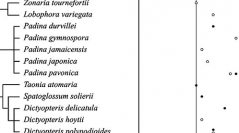

 Cryptogamie, Algologie
32 (2) - Pages 205-219
Cryptogamie, Algologie
32 (2) - Pages 205-219The DNA-localizing fluorochrome DAPI (4', 6-diamidino-2-phenylindole) and chicken erythrocytes standard (RBC) were used with image analysis and static microspectrophotometry to estimate nuclear DNA contents in 14 species and varieties of Dictyotales from the Atlantic Ocean (Spain and USA) and the Mediterranean Sea (Spain). Negligible differences were found between specimens fixed in Carnoy's solution (EtOH) and methanol-Carnoy's (methacarn). Present and previously published nuclear DNA content estimates expand our database to include 17 species and varieties representing seven genera with a 2C range of 0.7 - 1.7 pg. Intraplant variation (endopolyploidy) was observed in most isolates and 8C nuclei were quantified in five species. In four species, fluorescence intensity (If) levels in 2C gametophyte nuclei were found to closely approximate 50 of 4C values in vegetative cells of mature sporophytes, consistent with meiosis and a sexual life history in diplobiontic algae. Availability of consensus higher-level phylogenetic trees for Dictyotales has opened the way for determining evolutionary trends in DNA amounts. Both estimated genome sizes and published chromosome numbers for Dictyotales suggest that evolution in the order was accompanied by multiple, discrete polyploidy events which are largely obscured by subsequent small scale loss or gain of chromosomes (aneuploidy). Members of the genus Dictyota are characterized by a narrow range of 2C genome sizes (0.7-0.9 pg) relative to other Dictyotales investigated (1.0-1.7 pg).